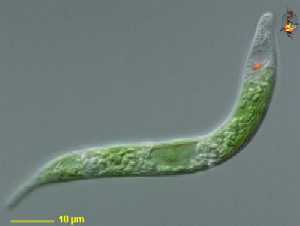From DamnInteresting

Just outside Butte, Montana lies a pit of greenish poison a mile and a half wide and over a third of a mile deep. The water became as acidic as lemon juice, creating a toxic brew of heavy metal poisons including arsenic, lead, and zinc. No fish live there, and no plants line the shores. There aren’t even any insects buzzing about. The Berkeley Pit had become one of the deadliest places on earth, too toxic even for microorganisms. Or so it was thought.
In 1995, an analytic chemist named William Chatham saw something unusual in the allegedly lifeless lake: a small clump of green slime floating on the water’s surface. He snagged a sample and brought it to biologist Grant Mitman at the nearby Montana Tech campus of the University of Montana, where Mitman found to his amazement that the goop was a mass of single-celled algae. This makes it a classic example of an extremophile.
 Euglena mutabilis
Euglena mutabilis
Extremophiles are organisms that can tolerate and even thrive in environments that will destroy most other living things. Some can even repair their own damaged DNA, a trait which makes them extremely interesting to cancer researchers.
Read More HERE